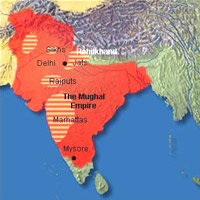The death of Alamgir in 1707 is generally regarded as the beginning of the gradual decline, and ultimately fall, of the once extensive, prosperous and powerful Mughal Empire. Although it took nearly 150 years before the House of Babur finally disappeared from the scene, the cracks that had appeared at Alamgir’s death widened.
His son Muazzam, who ruled from 1707 to 1712, succeeded Aurangzeb Alamgir. He took for himself the title of Bahadur Shah. He ruled for five years and momentarily revived the Mughal Empire. But the Marhatta’s power increased and they became the unchallenged rulers of Deccan. In the province of Punjab, the Sikhs under Guru Govind Singh became a force to reckon with. One of the reasons that power centers kept springing up outside Delhi was the frequent change in the succession of Empires. Nearly 17 kings were crowned during the period spanning from 1707 to 1857.
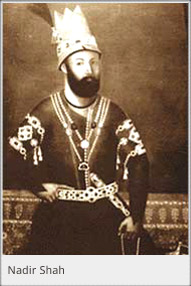 The weakened Mughal Empire invited havoc in the form of the Persian king Nadir Shah, in 1738-39. On his orders a general massacre of the citizens of Delhi was carried out, resulting in the death of 30,000 people. Another threat to the Mughal Empire came from the Afghans of Rohilkhand, lying northeast of Delhi. By the middle of 18th century, the Rohillas became independent of the Mughal rule. At the same time the Jats also raised their heads against the central rule.
The weakened Mughal Empire invited havoc in the form of the Persian king Nadir Shah, in 1738-39. On his orders a general massacre of the citizens of Delhi was carried out, resulting in the death of 30,000 people. Another threat to the Mughal Empire came from the Afghans of Rohilkhand, lying northeast of Delhi. By the middle of 18th century, the Rohillas became independent of the Mughal rule. At the same time the Jats also raised their heads against the central rule.
Taking advantage of this chaotic situation, the East India Company began strengthening its military capabilities. They conspired with Hindu traders and moneylenders against Nawab Sirajuddullah of Bengal to take over his principality. The Battle of Plassey of 1757 is considered a major breakthrough for the British in the Sub-continent. It paved the way for the company’s rule in Bengal, and hence the whole of India ultimately came under the company’s rule.
In the 19th century, Muslims like Syed Ahmad Brailvi and Shah Ismail carried out Jihad against the Sikhs, as did Haider Ali and Tipu Sultan in Deccan against the British. However, they failed in their efforts to stop the downfall of the Muslim rule. The final crunch came after the war of 1857 when the Mughal rule officially came to an end and India came under the direct rule of the British crown.
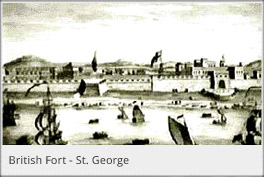 The Mughal Empire reached its greatest extent in the time of Aurangzeb Alamgir, but it collapsed with dramatic suddenness within a few decades after his death. The Mughal Empire owes its decline and ultimate downfall to a combination of factors; firstly Aurangzeb’s religious policy is regarded as a cause for the decline of the Mughal Empire as it led to disunity among the people. Although the policy did lead to weakening of the empire but the major cause of decline was the lack of worthy and competent successors after him. The character of Mughal kings had deteriorated over a period of time. The successive rulers after Aurangzeb were weak and lacked the character, motivation and commitment to rule the empire strongly. They had become ease loving and cowardly. They totally disregarded their state duties and were unable to detain the declining empire from its fall.
The Mughal Empire reached its greatest extent in the time of Aurangzeb Alamgir, but it collapsed with dramatic suddenness within a few decades after his death. The Mughal Empire owes its decline and ultimate downfall to a combination of factors; firstly Aurangzeb’s religious policy is regarded as a cause for the decline of the Mughal Empire as it led to disunity among the people. Although the policy did lead to weakening of the empire but the major cause of decline was the lack of worthy and competent successors after him. The character of Mughal kings had deteriorated over a period of time. The successive rulers after Aurangzeb were weak and lacked the character, motivation and commitment to rule the empire strongly. They had become ease loving and cowardly. They totally disregarded their state duties and were unable to detain the declining empire from its fall.
The absence of any definite law of accession was another important factor. The war of successions not only led to bitterness, bloodshed, and loss of money and prestige of the empire over a period of time, but to its eventual fall. The degeneration of the rulers had also led to the moral degeneration of the nobility. Under the early Mughals, the nobles performed useful functions and distinguished themselves both in war and peace. But the elite under the later Mughals was more interested in worldly pursuit and self-enhancement. The nobles who had once been talented men with integrity, honesty, and loyalty, turned selfish and deceitful. Growth of hostile and rival clique in the court also undermined the strength of the government. Widespread corruption in the administration started and taking bribes became common.
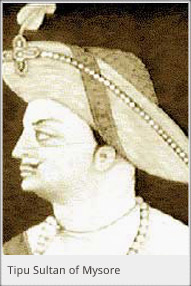 One of the most potent causes of the fall of the Mughal Empire was the deterioration and demoralization of the army. The military had not only become inefficient but also lacked in training, discipline and cohesion. The army was out-dated in regard to equipment. It consisted of contingents maintained by various nobles, which was the main source of Army’s weakness. As the weakening of the nobles occurred, so did the army.
One of the most potent causes of the fall of the Mughal Empire was the deterioration and demoralization of the army. The military had not only become inefficient but also lacked in training, discipline and cohesion. The army was out-dated in regard to equipment. It consisted of contingents maintained by various nobles, which was the main source of Army’s weakness. As the weakening of the nobles occurred, so did the army.
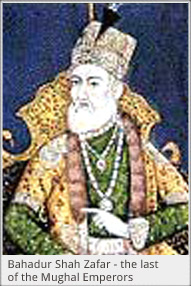
This was because of the soldiers, instead of identifying and uniting as Mughal Indians, identified themselves with different ethnic groups like Persian, Afghans and Central Asians. The Mughals had no navy and only maintained small ships that were no match for the well-equipped ships of the foreign traders. It was this weakness that the French and the British used to their advantage, and were eventually able to establish their control over India.
 Another factor contributing to the decline was the financial position of the Mughals, which had become deplorable. The war of successions, rebellions and luxurious style of living had depleted the once enormous treasury and had led to financial bankruptcy. During the time of Aurangzeb, the Mughal Empire had expanded to reach its maximum size. This vast area had become impossible for one ruler to control and govern from one center. It was during the later Mughals that Deccan, Bengal, Bihar and Orrisa declared their independence. The raids by Nadir Shah, and repeated invasions of Ahmad Shah Abdali, resulted in further weakening of the empire. The already weakened empire faced further encroachment by the British and the French, which proved to be the last nail in the already drowning empire’s coffin. The British and French, who had initially come as traders, took full advantage of the weakening empire and soon became masters of the whole of India.
Another factor contributing to the decline was the financial position of the Mughals, which had become deplorable. The war of successions, rebellions and luxurious style of living had depleted the once enormous treasury and had led to financial bankruptcy. During the time of Aurangzeb, the Mughal Empire had expanded to reach its maximum size. This vast area had become impossible for one ruler to control and govern from one center. It was during the later Mughals that Deccan, Bengal, Bihar and Orrisa declared their independence. The raids by Nadir Shah, and repeated invasions of Ahmad Shah Abdali, resulted in further weakening of the empire. The already weakened empire faced further encroachment by the British and the French, which proved to be the last nail in the already drowning empire’s coffin. The British and French, who had initially come as traders, took full advantage of the weakening empire and soon became masters of the whole of India.
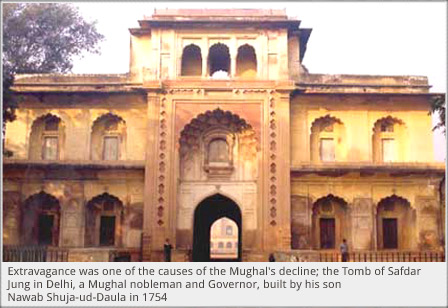
This article was last updated on Sunday, June 01, 2003




